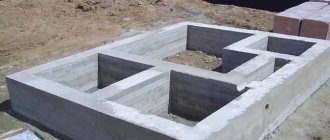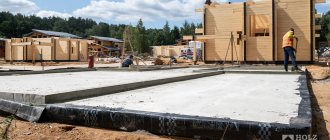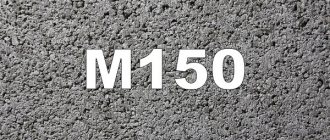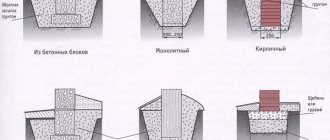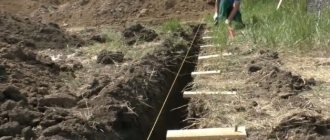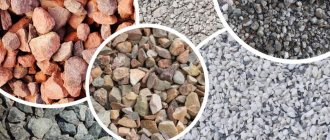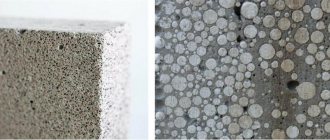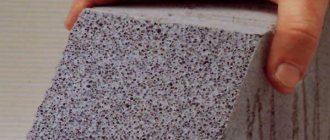Behind the general term “pile foundation” lies an impressive list of varieties of this foundation, each of which has its own advantages, disadvantages and “indications for use.”
The optimal choice of the type of pile, grillage design and method of installation of the base will not only help simplify and reduce the cost of construction work, but will also ensure the maximum service life of the building.
That is why the developer must have a good understanding of what types of pile foundations can be used today and how to choose the most preferable option.
Pile foundations
The design of a pile foundation consists of a group of piles and grillages, which are the connecting and load-distributing link of the structure. The ground parts of the buildings are supported on load-bearing slabs or beams connecting the piles. Depending on their location relative to the horizon, grillages are:
- low - they are below the ground level and transmit part of the force to the ground through their sole. As a rule, they are installed no higher than the freezing mark;
- intermediate - laid without deepening directly on the surface layer of non-heaving soils. Vertical pressure is not transmitted along the sole;
- high - located above ground level under the internal walls of houses in the presence of a technical underground, as well as under bridge supports, etc. The rigidity of this structure is provided by additional inclined piles.
The construction design may provide for different locations of pile shafts:
- single – for light frame buildings;
- strip (single or multi-row) - for load-bearing walls of extended structures;
- bush - for massive columns and pillars;
- solid - for towers and high-rise buildings with a small area in plan.
Using different types of piles when constructing foundations in civil engineering, it is possible to increase the volume of housing for rent by increasing the number of floors of buildings, as well as using sites with soils that have unsatisfactory characteristics. In addition, one can note a significant reduction in labor intensity and a reduction in time at the excavation stage, compared to the open method of installing the underground part of the structure, which gives the developer an economic benefit.
08/24/2015 at 14:08
Home | About us | Feedback
Construction of pile foundations
This structural element is a special rod that is designed to be immersed in the soil
Let's first look at the features of piles. This structural element is a special rod that is designed to be immersed in the soil. The finished component usually has a point pointed upward, with which they are buried in the ground. If you make a pile yourself, then you need to make holes with a drill, lay the reinforcement and fill it with mortar. This building element is divided according to the manufacturing method:
- Material;
- Manufacturing method;
- Shape: longitudinal or transverse;
- Immersion method.
The classification based on the method of immersing piles into the earth cover looks like this:
- Driven piles - this type is installed by driving with vibratory hammers;
- Pressed type - created from reinforced concrete or concrete and drilled wells, which are filled with concrete;
- Drilled piles made of reinforced concrete material, which are mounted in a drilled well;
- Screw type that must be installed by hand. The installation method is to twist the piles like a drill.
According to the method of influencing the soil, there are the following types:
- Hanging pile. Their ability to distribute loads is manifested due to the assistance of the soil and the lateral part of this type.
- Piles are racks. This device is characterized by transporting the load to the strongest section of the soil. The advantage of this foundation is its ability to retain precipitation as much as possible.
There is another classification based on such criteria as the placement of piles:
- Single type, which is characterized by independent support not connected to any other fastenings;
- Collective type. This type is characterized by the combination of several support points into strips, which are placed parallel to the walls, where the entire load is distributed. It is worth noting that such tapes can be installed in one or many lines.
- Bushes made of piles. So-called bushes can form, which are placed under frame columns. Their peculiarity is that these connections can form at several points of the perimeter.
Types of reinforced concrete piles - these types of pile foundations can be built directly on the site of the construction site, but this process requires specialized equipment
- Types of reinforced concrete piles - these types of pile foundations can be built directly on the site of the construction site, but this process requires specialized equipment. It is worth noting that the grade of concrete should be higher than 200. The service life of these grillages is more than a century.
- Steel grillage models. These types have a fairly large number of disadvantages. Firstly, installation is performed by a large number of specialized equipment. And secondly, there is a need to treat the metal with special anti-corrosion substances.
- Wooden piles. The appearance of such grillages is smooth, cleaned pillars. Their dimensions are 0.3 meters in diameter and up to 9 meters in length. Coniferous wood is used for their manufacture - this is the cheapest option, but is rarely used in practice. This happens because such material is subject to rotting processes.
Constructive decisions
The construction of the facility requires the development of a plan for the construction of the base and support beams . It should cover the following aspects:
- location of supporting structures;
- dimensions of bars - length, diameter;
- settlement;
- consumption of raw materials.
Construction work must be carried out following a simple algorithm. Decide on the type of piles, their shape, diameter - the average size is 200, 250, 400 mm. Level the area, carry out the necessary straightening, mark the points for driving in the supports. The depth of the wells is calculated for each complex separately, but must be deeper than the soil freezing level. The load-bearing base requires special attention - the beams rest on it under strong pressure. Make sure that the perimeter of the object is strictly rectangular. After marking, start drilling, first removing the top layer of soil. Prepare a mixture of crushed stone and sand, fill the depressions with it, insert a reinforced frame, fill it with concrete, and thoroughly compress it. The hardening time is 20-30 days. Build a grillage and install it on the rods. Assemble the formwork, fill it with concrete, wait for at least 20 days to harden. The final stage is waterproofing.
Waterproofing is a set of procedures aimed at preserving the properties of the structure, protecting against moisture, corrosion, and fungal infections.
Pile-grillage foundation.
Screw pile design
Contrary to popular belief, steel screw piles (SVP) were created not to reduce the construction budget, but to ensure guaranteed compensation of heaving forces on the foundation elements and to easily reach the lower supporting layers. There are different types of screw piles for low-rise construction, but their design is largely similar:
- body - seamless pipe (4 - 4.5 mm wall), usually made of St3 steel, structures made of 30KhMA steel, wall thickness 6 - 10 mm, have the maximum service life;
- blades - welded onto the body or have the form of an independent tip (welding, casting) welded to the body of the pile.
This design is multifunctional - the blades convert torque into longitudinal movement during immersion, compensate for horizontal forces, ensuring geometry stability. Therefore, houses on SHS can be built on permafrost, weak and heaving soils.
Types of screw piles
Rice. 1. Types of screw piles.
Before choosing screw piles for the foundation of a house, it is necessary to study the requirements of SNiP standards dated 1985, number 2.02.03 (design of pile fields), or rather the latest edition of 2011 - SP 24.13330 for calculating the bearing capacity of the foundation.
There are several types of SHS for various structures:
- narrow-bladed - a multi-turn analogue of a screw, the cast tip is connected to the body of the pile by welding; for permafrost, options with teeth along the perimeter of the lower cut are used (Fig. 1, Var. 4); for soils with a high content of stones, fragments and dense rocks, pointed tips are used ( Fig. 1, Ver. 3);
- broad-bladed - one blade of a cast tip with 1–1.5 starts (Fig. 1, Var. 1);
- multi-bladed – several blades along the length for improved support and compensation of vertical movements (Fig. 1, Ver. 2).
Buildings with the maximum permitted number of storeys (3 levels with an attic) in low-rise construction can be built exclusively on multi-blade SHS. For light buildings, single-blade modifications with a wide propeller or a narrow tip spiral, depending on the type of soil, are sufficient. Standard markings are provided for screw piles:
- SWS – welded tip;
- VSL – cast tip;
- SVK – conical modification, can be designated SVS-K;
- SVP - the design is supplemented with a lance, warrant designation SVS-P;
- VAU – screw-type anchor device (prefabricated structure).
Cast screw pile tip.
To solve specific problems, manufacturers produce piles of variable diameters and complex configurations:
- Z series – screw anchor for lightweight structures;
- T series – head plate with mounting holes;
- U series – U-shaped head;
- series F – round flange;
- R series – square flange.
The standard diameters of SVS and SVL are 57 – 325 mm. Special series products have a maximum size of 159 mm. The marking consistently reflects the type of pile, shaft diameter, wall thickness, blade dimensions, and total length of the product. There are marking features of individual manufacturers. For example, the Fundex company adds F1, F2 after the standard designation (two, one blade, respectively).
Screw pile diagram.
In the middle of the 20th century, the most durable SVL with the following characteristics was produced for the needs of the army:
- cast tip;
- screw 14 mm, 6 mm (near the cone, from the edge, respectively);
- seamless pipe (St20);
- hot galvanizing (140 – 200 microns).
With a stated service life of 100–180 years, these products are still in use, so the actual service life is not yet known.
Area of use
Staircase on screw piles.
In 70% of cases, individual developers do not suspect that SHS can be used not only for supporting cottages and bathhouses, but also for making foundations for the following structures, significantly reducing construction time:
- noise barriers, fences;
- gazebos, greenhouses, small architectural forms;
- strengthening of monolithic foundations (slab, tape);
- guys, anchors, power line poles;
- temporary structures with the possibility of dismantling (attractions, pavilions);
- bridges, piers, slope strengthening;
- advertising designs.
SNiP standards provide detailed instructions on how to select screw piles for specific operating conditions. For greater reliability, it is recommended to paint products with special anti-corrosion coatings.
Metal piles
A rolled profile is used as piles: an I-beam, channel or pipe. Sometimes they are pre-prepared. To do this, weld 2 channels together, thus obtaining a square pipe.
Piles can also be of an open section. They are made by welding corners, rails, I-beams.
Metal is used in cases where it is impossible to install reinforced concrete piles. It is easier to build it up as it goes deeper into the ground.
Metal profiles have high strength, which simplifies their driving into the ground. For a small cross-section, solid inclusions or destroyed rocky soils are not dangerous.
Piles are driven into the ground with a hammer or press. For depths up to 5 m, a hand hammer is sufficient.
Special types of piles among metal products are screw piles. Providing high strength, they are more economical and technologically advanced than reinforced concrete foundations. Piles are hollow pipes with external blades. They are screwed into the soil like screws, preserving its structure and further compacting it. In this case, rotation in the opposite direction is not allowed, so as not to deteriorate the characteristics of the base.
Bottom line
| Technology / Structure: | Bathhouse / Terrace / Garage | Wooden house (timber/log/frame) | Aerated concrete house (foam block, aerated concrete) | Stone house (brick, monolith) |
| Screw piles | 5 | 5 | 3 | X |
| RCC driven piles | X* | 3 | 5 | 5 |
* irrational costs
Small buildings and wooden houses made of timber or logs
Speaking about garages, bathhouses, terraces, gazebos, fences, cabins and other small and light buildings, we note that it is not rational to use reinforced concrete piles. For an ordinary timber or log house with a residential attic, screw piles are often also more preferable. But if we are talking about a large house, and you are betting on durability, then you can consider the option of a reinforced concrete driven foundation, because in the ground concrete practically does not collapse and does not deteriorate.
House made of lightweight concrete (foam blocks or aerated concrete)
For this type of building, both screw piles and reinforced reinforced concrete piles are suitable. In the first case, it is worth choosing supports of large diameter and further strengthening the foundation. In the second, it is enough to choose the right section. In addition, on reinforced concrete piles paired with a shallow grillage of 600x400 mm, you can safely build even a three-story brick house.
Grillage installation
No structure can be located solely on stilts. A grillage is required, which combines the piles into a single structure and creates a foundation for the construction of walls.
Grillages can be prefabricated or monolithic in the form of beams lying on piles or a solid slab covering all the piles.
Grillage
If prefabricated grillages are used, the accuracy of driving the piles must be very high. Horizontally, the piles should not have deviations of more or less than 0.05 m, and vertically 0.01 m. The installation of combined grillages allows large deviations, since the pile foundation assembly is made in a monolithic design in removable formwork.
Based on their height from the ground, there are high and low grillages. When constructing a high grillage, a free space is created between the ground surface and the grillage, which is subsequently sealed using a backfill (the outer wall between the piles). Low grillages can be in contact with the ground or be immersed in it, but this option is only possible with non-heaving soils.
Advantages and disadvantages of pile foundations
The use of pile foundations has its advantages:
- pile foundations can be erected on soils of any complexity;
- the volume of excavation work is reduced, since there is no need to dig pits or trenches;
- the consumption of concrete and reinforcement is reduced by reducing the entire volume of the foundation;
- foundation work can be carried out all year round, not excluding the winter period;
- structures erected on pile foundations are particularly resistant to floods and soil movements due to winter heaving.
However, despite all the advantages of pile foundations, they are erected extremely rarely in individual housing construction due to the high cost of transportation costs for the delivery of piles and due to the use of pile driving equipment.
The classification of foundations occurs according to numerous criteria, it depends on:
- depending on the type of piles;
- depending on the location of the piles - free-standing piles, arranged in a bush, strip arrangement, continuous field of piles;
- on the type of connection of the pile with the building under construction - with or without a grillage;
- depending on the type of grillage – high or low;
- from the design of the grillage - monolithic, prefabricated or combined;
- depending on the type of connection between the grillage and the piles - rigid, free support, with the installation of seismic belts.
Among the types of pile foundations, the most commonly used are reinforced concrete piles, which combine the properties of hanging piles and rack piles.
When constructing frame multi-story buildings, pile-slab foundations are used. This decision of the designers is due to those areas where the seismic situation is unstable and there is a risk of ground movement during earthquakes. The essence of this engineering invention is to create the necessary rigidity of piles and reinforced concrete slabs, which ensure joint deformation of foundation elements under seismic loads.
Pile-slab foundation
The piles are arranged using the cluster method, after which a grillage is made with the release of reinforcement for the subsequent fastening of a thin reinforced concrete slab. A seam is made of a sealed material between the grillage and the concrete slab, which ensures independent settlement of the building, waterproofing the structure, and at the same time reacts to seismic changes in the soil.
Bored pile foundations are most often used in the construction of individual residential buildings due to its cost-effectiveness and simplified technology compared to other types of piles. For small buildings and shallow hard soils, wells for piles can even be drilled manually with special drills or holes of appropriate depth can be dug.
In any case, the volume of excavation work will be less than when installing a monolithic or prefabricated strip foundation.
If the soil is hard and does not crumble, the formwork may not be installed. Otherwise, roofing material, polyethylene film or cardboard in the form of a roll is inserted into the well, into which the reinforcement cage is already inserted and concrete is poured.
The pile foundation for columns, if the house design provides for such, is made without grillages. Ready-made structures in the form of reinforced concrete cups, caps or caps are used for columns.
For small buildings - fences, sheds, frame houses - column piles are used. This is a driven pile of round or square cross-section, which is a continuation of the column in the above-ground part of the building or structure. In this case, there is no need to arrange a grillage.
About the site
zalman
Brief description of installation technology
The procedure is as follows:
- Site preparation. Excess plants and objects are removed, the site is planned, if necessary.
- Marking. Using pegs, the centers of the wells are marked. It is necessary to maintain the accuracy and precision of measurements and check the correspondence of the diagonals.
- Drilling of the wells. Wells are drilled to a given (or possible) depth, and if necessary, an expansion is made - the heel.
- Sleeves are lowered into the cavity - sections of plastic pipes, roofing felt rolled into a tube. They will serve as a kind of formwork that prevents water from leaving the concrete into the surrounding soil.
- Reinforcing cages are assembled and lowered into the wells. Their length should be such that there is enough left for subsequent connection with the armored belt of the grillage.
- Concrete is poured into the wells. It is carefully bayoneted, removing air bubbles. After this, the piles are kept until completely hardened (28 days).
- While the concrete dries, the formwork and reinforcement cage for the grillage are assembled. The procedure is almost the same as the method for constructing a strip foundation.
- When the opportunity arises, the grillage is poured. The concrete is bayoneted, removing air, then covered with polyethylene and kept for 28 days. The formwork can be removed 10 days after pouring.
After the tape has completely hardened, you can proceed to further construction.
Driven reinforced concrete piles
Standard driven reinforced concrete piles are manufactured in factories and delivered to construction sites in finished form. They are standardized by design, cross-section, length, reinforcement, and grade of concrete used.
Classified according to the method of reinforcement:
- piles with non-tensioned longitudinal reinforcement with transverse reinforcement,
- with prestressed longitudinal reinforcement, with and without transverse reinforcement.
- solid,
- composite (from separate sections)
According to heel geometry:
- pointed (with a point),
- blunt (no point).
Individual sections of composite piles are connected using a special “glass” joint and fixed by bolting or welding immediately after driving the first lower section, after which the full length is driven.
A conventional type of bored piles are solid or composite, hollow or solid, square or round piles, immersed in pre-drilled leader holes.
Driven piles are produced in accordance with GOST 19804-2012 “Prefabricated reinforced concrete piles” and are divided into the following main types:
C - square solid section, solid and composite, with transverse reinforcement (series 1.011.1-10);
SP - square section with a round cavity, without a point, solid, more affordable due to the reduced consumption of concrete during production, wall thickness from 40 to 65 mm depending on the grade of concrete used (at least M200), prestressed or non-prestressed reinforcement ( GOST 19804.3);
SK - hollow round section with a diameter of 400-800 mm, without a tip, solid and composite, with non-stressed reinforcement (series 3.501.1);
SO - shell piles with a diameter of 1000-3000 mm, solid and composite, with non-prestressed reinforcement (series 3.501.1);
1SD - column piles of square solid section, without a point, double-cantilever, located along the extreme axes of the building (GOST 19804.7-83);
2SD - the same, located along the middle axes of the building;
SC - square solid section, solid, without transverse reinforcement of the shaft, with prestressed reinforcement in the center of the pile (GOST 19804.4).
The range of driven reinforced concrete piles is dictated by the variety of applications depending on the structures of the above-foundation part of the structures and the soil conditions of the construction site. Ready-made driven reinforced concrete piles have a number of significant advantages compared to other types: low cost, low cost of driving, simple and inexpensive equipment to operate, and low requirements for personnel qualifications. The lion's share of pile foundations is carried out using them.
Based on the principle of minimizing costs, preference is given to those types of piles that, subject to all design parameters, meet the requirements of the construction budget. Local site conditions may also influence the choice of foundation supports. The pile foundation ends with a grillage or foundation slab.
Driving piles
Driving reinforced concrete piles using a pile driver with a diesel hammer
The classic scheme involves driving a vertically installed pile by striking its head with a hammer until the design failure or the design depth is reached. The machine for driving piles (piling machine, pile driver) is a hammer on a base machine. The base machine is a crawler crane, a bulldozer or an off-road vehicle.
The most common, easy to operate and relatively inexpensive hammer is a diesel pile driver hammer, placed on the mast of the base machine as an attachment. Its impact force is not adjustable during operation. But a hydraulic hammer has more flexible characteristics and is capable of finely adjusting the impact force during operation.
Driving machine with hydraulic hammer
For conditions of dense urban development, the requirement to comply with the safety of piling work for the foundations of nearby buildings, as well as the noise level, becomes critical. For driven piles, compliance with this requirement is achieved by using non-impact pile driving alternatives to driving: vibration driving and indentation. In terms of cost, vibration immersion is approximately 2 times more expensive, and indentation is 2.5 times more expensive.
Pressing piles in Moscow in winter conditions
For driving using the indentation method, cheaper piles without reinforced reinforcement are used, since there is no need to protect the head of the column from impacts with a pile driver’s hammer. In addition, costs are reduced due to the reduction of immersion points, due to a significant reduction in the rejection of pile elements.
Material of manufacture
It is necessary to dwell in more detail on the materials from which piles for foundations are made:
- reinforced concrete. Prefabricated structures are produced in factories. Monolithic pillars are manufactured on construction sites according to a design developed by architects. The use of ordinary or prestressed reinforcement is allowed. Heavy concrete can be used as a fill, in which it is necessary to comply with frost resistance indicators;
- metal. Most often, rolled profiles or welded structures are used as a basis. The cast pole is more reliable than the welded version due to the absence of potentially vulnerable areas. To enhance protection against corrosion, the metal surface is coated with zinc, coal tar or bitumen. The blades can also be cast or welded. The manufacture of blades is allowed using cast iron and even plastic;
- tree. Such piles are based on pine or spruce. You can also release posts from cedar and oak. The best option is straight-trunked logs, previously cleared of bark. The lower part of the post must be sharpened, and in particularly dense soil a metal shoe will be required, which protects the product from destruction during installation using a hammer.
The most durable option is metal if it is properly processed and the cavity inside the column is filled with concrete. In addition, we must not forget the possibility of re-using metal piles after dismantling the old building.
Advantages and disadvantages
pros
- Installation of a pile foundation will not take much time.
- If the marking of the pile field is done correctly and high-quality material has been selected, the service life of the screw piles will be several decades.
- If you know how to build a structure correctly, the costs will be minimal.
- It can be built in almost any area and in any climate, including in a swamp or in places where it is always cold.
- The soil temperature at depth is always stable and does not in any way affect the installation of structures in winter.
- Utilities can be installed both during and after the construction of the foundation.
Minuses
- A pile field does not perform its function well if the soil can move horizontally or swells. To determine the soil, it is necessary to conduct geological studies.
- During the work process, problems arise with the installation of the basement floor. The gap between the piles must be filled. These are unnecessary expenses.
- Any material is subject to corrosion. It all depends on the environment. Quality materials are specially coated to provide years of protection. But they are also not eternal. And sometimes it is precisely these protective measures that become the cause of corrosion. Some soils may contain chemical elements that, when in contact with protective materials, can cause foundation failure.
- It is almost impossible to build in rocky or rocky terrain, even with special machines.
- It is necessary to install a drainage system. It is expensive.
- Problems may arise when installed near other houses. This can be avoided using special equipment.
When choosing a foundation, it is necessary to consider all the shortcomings of existing design options. Otherwise, the pile foundation for the house may become problematic. The demand for pile foundations is growing every year.
Price
The price of a rod 108/300, 1650 mm long, with a welded tip is 1550 rubles. 3000 mm – 2050 rubles. A similar 3-meter pile, but with a cast tip, will cost 3,200 rubles. Also, to connect the supports, they use a head that costs 300 rubles.
The price of the work depends on the characteristics of the piles, soil and other factors. Approximately:
- installation of a rod 108/300/1650 mm – 1500 rubles;
- 108/300/3000 mm – 1900 rubles;
- 133/350/1650 mm – 1650 rubles;
- 133/350/3000 mm – 2400 rubles.
It is also worth adding to the work:
- strapping (500 – 1000 rubles per linear meter);
- drilling holes (from 300 rubles);
- trial twisting (2000 rubles);
- rental of a generator (if there is no electricity on the site or the existing network is not capable of providing a power of 5 kW).
Types of pile designs
Driven piles.
Piles are made from materials such as:
- Reinforced concrete. The most common option. Installation of reinforced concrete foundations is the simplest, as it involves the use of the drilling method, in which a pile structure is created directly in the ground. It is also possible to install ready-made reinforced concrete structures with screw threads.
- Metal. Metal piles are represented by channels, pipes, rails and I-beams welded together. They are easy to install in the ground and are used where reinforced concrete structures cannot be installed. The main disadvantage of such piles is their susceptibility to corrosion. Metal pipes can be hollow or filled with concrete mixture.
- Tree. Coniferous wood or oak is used as raw material. Wooden piles are able to withstand moderate loads; as a rule, they are used in permafrost conditions, where rotting processes slow down significantly. In other regions, the use of wooden foundations is limited, as exposure to moisture accelerates their rotting and shortens their service life.
Metal screw piles.
The following section shapes are distinguished:
- Square.
- Round hollow and filled.
- Rectangular.
- T-shaped (shaped like the letter “T”).
- I-beam (similar in shape to the letter “H”).
To strengthen the structure, the supporting heels of the piles are expanded, but it is possible to install them without expansion. Support heels can be:
- Drillable with a bit to widen the bottom.
- Pressed out.
- Camouflage - the heel expands using a chemical or electrical explosion.
Priming
Much depends on the conditions at the site. If the soil is highly acidic, then installing screw piles is dangerous, as they will quickly rot. Therefore, it is worth doing a soil test before starting construction to avoid risk.
There are areas with a large difference in ground level or water-logged soil. In this case, on the contrary, it is worth giving preference to screw piles, because during installation they can be increased until the blade reaches dense soil. In addition, due to the wide base, the screw pile will be more stable in this type of soil, where a concrete pile can simply fall deep into the ground.
